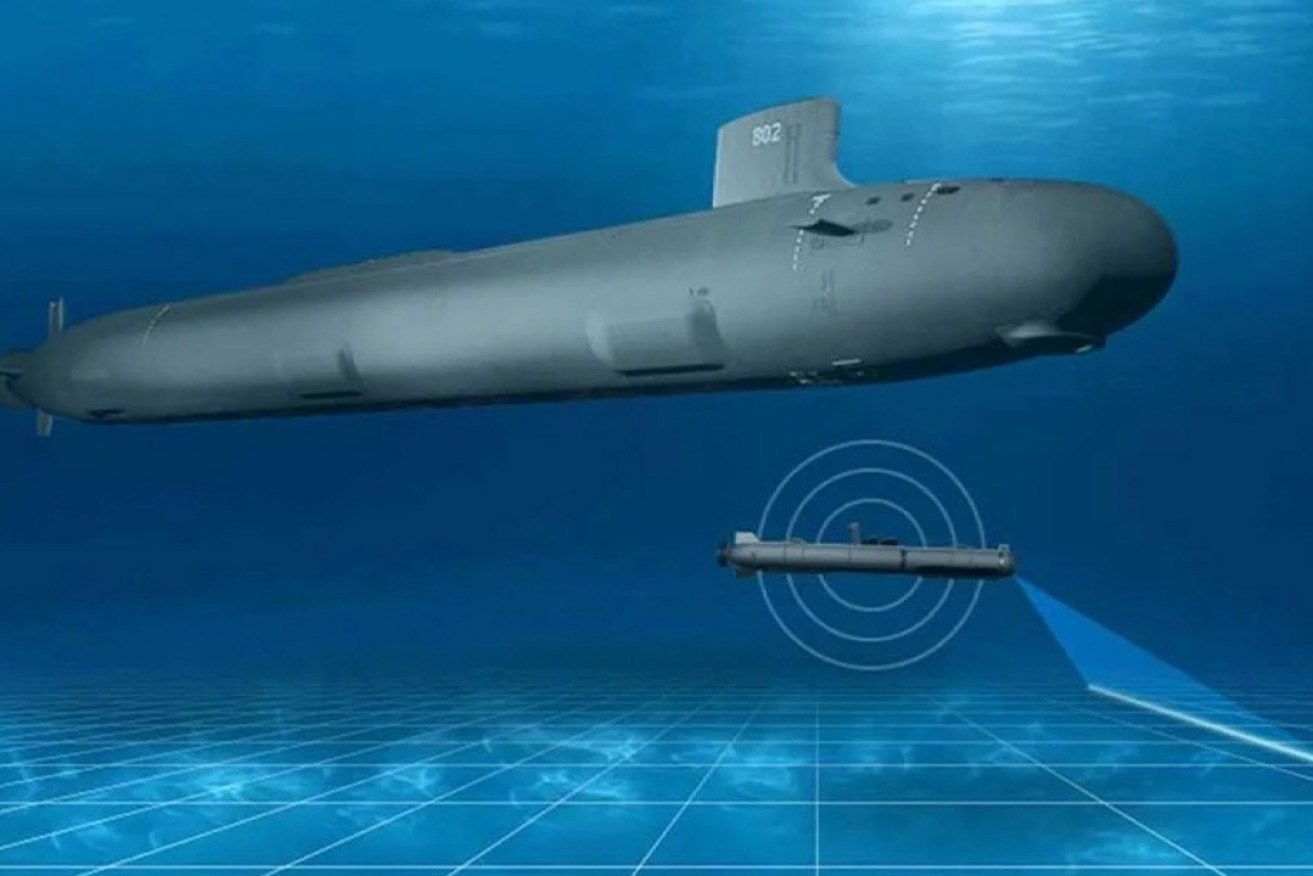The devilishly difficult needs of naval drones
The answer to AI-driven submersibles could lie in a suburban Adelaide lab – meet the two researchers testing the limits.

Extra-large unmanned underwater vehicles (XLUUVs) present an opportunity to launch and recover (LAR) smaller autonomous underwater vehicles (AUVs). Photo: Supplied
“Autonomous submarines are set to change how Australia patrols the oceans,” declares a Financial Review report. Meanwhile, the builder of the Ghost Shark unmanned submersible predicts navies will increasingly rely on smaller uncrewed systems as the oceans become more “transparent”.
AUKUS, the defence technology agreement between Australia the UK and the US, is generating advances in defence capability from nuclear submarines to hypersonic weapons and drone swarms.
The feature of the machines of the future is that they must be able to make decisions by and among themselves.
Part of the solution is lurking in a lab at Tonsley Park, but it must graduate from machine-learning school before being released in the wild.
“There’s a lot of hype that drones are capable of doing everything. They’re not,” says Professor Karl Sammut of the Flinders University College of Science and Engineering.
“We have the platforms. We’re making them as robust as possible. What’s lacking at the moment are the brains needed to turn their potential into reality.”
“We need these vehicles to be able to think – to make their own decisions, without any human in the loop.”
But Flinders PhD candidate Zachary Cooper-Baldock says teaching artificial intelligence to responsibly control a vehicle in an environment many times more difficult than air makes space travel sound easy.
“That’s what I keep telling everyone!” he says.
Submarines – especially Australian ones – must travel far further and longer than your average aircraft. That takes a lot of energy. And that requires considerable size and complexity. At this point, human crews are very much a key part of that equation.
Submarines must stay deep. They must stay utterly silent. They can be isolated from the outside world for months at a time. And that puts enormous emphasis on the judgement calls of its commander.
But there is a way to dramatically reduce the risks submarine crews must expose themselves to.
Drones.
The idea sounds simple enough. Submarine opens a hatch. A small vehicle glides in.
But there’s a catch. It’s called physics.
Water is heavy. Water is 1000 times denser than air. Water transmits sound. And everything about water flow is so much harder than aerodynamics.
But that’s not stopping Flinders University researchers.
Cooper-Baldock and Sammut and the team are working on teaching a drone to dock with a mothership, without communications or acoustic sensors. Quietly. Safely. All by itself.
Extra-large unmanned underwater vehicles (XLUUVs) present an opportunity to launch and recover (LAR) smaller autonomous underwater vehicles (AUVs) covertly in contested regions, increasing their operational range, time on station, data transmission and operational safety.
“Building the hardware is complicated, but it’s not the hardest part of the problem,” adds Sammut.
“We need these vehicles to be able to think – to make their own decisions, without any human in the loop.”
Why build submarines to carry smaller submarines?
“The point is that the underwater drones can move quietly into areas that are too dangerous to send a crewed submarine into,” says Sammut.
Anti-submarine technology is advancing at pace. Satellites, wake detectors, quantum gravity sensors all mean submarines need to find new ways to conduct their roles safer.
Smaller may make drones cheaper and harder to find. But it takes a lot of batteries to power one through the water. So they must be carried closer to their location, and recovered for a recharge.
Torpedoes, which have been fired from submarines for well over a century, are already in most military submarines.
Open a hatch. Equalise the pressure. Push it out. Let its onboard sensors drive it to a target.
But torpedoes have no “reverse” gear. And you really don’t want that much explosive coming back at you anyway.
With or without a warhead, torpedoes are designed to operate at high speeds. The long, thin body has a powerful motor driving a single rear propeller, along with small fins to nudge it in the desired direction.
Underwater drones can move quietly into areas that are too dangerous to send a crewed submarine
“If it’s moving slowly, you don’t have much control authority,” says Cooper-Baldock.
That means damaging (and noisy) bumps and scrapes when it comes home.
What about latching drones to the outside of a submarine?
“This is going to cause a very big change in the drag force,” he explains.
“This means that the mothership is going to expend more precious energy, and make noise.”
A drone also must push into the submarine’s underwater wake – a streamlined, powerful flow of water rushing along its hull. And then emerge again.
Once a submerged vessel stops, it has no control. It needs forward momentum for rudders and hydroplanes to work. Without that, it’s drifting at the mercy of the ebb and flow of tides and currents.
So, how can a drone pass through this turbulence sandwich without being tossed aside?
Sammut and Cooper-Baldock have run simulations to determine what kind of drone would best be able to dock and which places the least demands on the mothership.
“It is really complicated in terms of all the things that can go wrong and how the vehicles have to be able to recover from it,” says Sammut.
A traditional torpedo shape with steering fins may be the most efficient at moving through the water, but the control complexity needed to fly it up at an angle through the flow barrier without being spun out of control is prohibitive.
Then there’s the matter of stopping safely once on the other side.
“If you can’t control it, its bow can hit the freestream again, and it’s just going to get ripped out of the payload bay – which is obviously very, very bad from a risk perspective,” says Cooper-Baldock.
Retaining the torpedo shape maintains the streamlining needed for underwater efficiency.
But adding small, impeller thrusters to its nose and tail gives it five-dimensional movement control.
That means the drone can angle itself optimally to confront the submarine’s wake and make major adjustments in thrust to stay on course. Not to mention stop on the other side.
As always, there’s a tradeoff. The impellers take up valuable space and add weight.
“It also has much higher drag, but it’s extremely consistent drag. We can accommodate that,” says Cooper-Baldock.
“And we’ve found that commercial thrusters work perfectly fine – so there’s no need to go to tender for an expensive new propeller design.”
Fish out of water
Flinders University is testing a modified GRAALtech X300 drone in its own pool, but that can’t recreate the variability of conditions experienced in the open ocean.
“Experimental testing with a crewed submarine or an XLUUV would be prohibitively expensive and potentially quite dangerous,” says Cooper-Baldock.
“So we’ve sat down to do the computational fluid modelling, mathematical modelling, and digital twins of each system.”
The team now knows it has a machine capable of doing the job.
“But we’ve got a system that doesn’t yet know how to control itself to get into a docking bay. And it has to be able to do that all by itself, with no help. Yeah, it’s a fun rabbit hole…” quips Cooper-Baldock.
“Machine learning is only as good as the learning part,” says Sammut. “So we have to find ways to make it learn as much as possible as fast as possible.”
Like training a dog, reinforcement learning – “rewarding” good behaviour in repeated lessons – is a staple of the AI trade. But sometimes, you must fall off your bike a few times before getting a “feel” for how it works. Can you convince an AI to pick itself up off the ground and give it another try?
“You just have to make sure it’s as well informed as it can be before running it through a simulated training regime,” Cooper-Baldock says.
“It’s relatively simple to build very good hardware very quickly. The problem arises when you want to use the hardware to deal with contingencies that you haven’t foreseen.
“It needs a control system that knows how to deal with its environment. And then you have to validate that it’s not going to damage itself – or anything else – the moment you try and move it into the real world.
“That’s the tough bit.”
This story first appeared in Cosmos.




